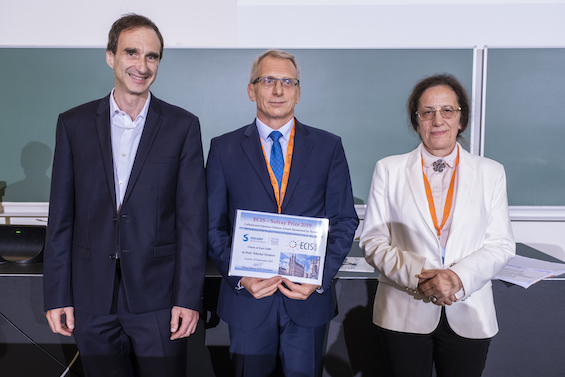
Professor Nikolai Denkov works in the area of colloid and interface science, with special focus on surfactants, foams and emulsions. He published more than 165 publications. The main science-metric indicators, according to Web of Science (2019) are h-index = 45, > 7200 citations (self-citations excluded). Among his publications one could note 2 papers in Nature (N. Denkov is first author in both), 1 paper in Nature Comm., 6 papers in Adv. Colloid Interface Sci., 5 papers in Phys. Rev. Lett. (N. Denkov is first author in 4 of them), 48 papers in Langmuir, 19 papers in J. Colloid Interface Sci., 20 papers in Colloids & Surfaces A, 4 papers in Soft Matter – all highly respected journals in the area of colloid and interface science. N. Denkov is co-author of 8 review-chapters in books, 12 invited reviews in journals, and co-inventor in 8 international patents. He has been the supervisor and co-supervisor of 12 completed PhD Theses. Two of his former PhD students (Dr. K. Golemanov and Dr. N. Christov) currently work at Solvay R&D Centre in Singapore.
During his career Prof. Denkov has made influential contributions in the areas of antifoams (Adv. Colloid Interface 2014, Langmuir 2004); foam rheology (Soft Matter 2009; chapter “Foam Rheology” in Foam Engineering, 2012); emulsification and emulsion stability (together with Prof. S. Tcholakova; PCCP 2008, Adv. Colloid Interface Sci. 2006, J. Colloid Interface Sci. 2007); 2D-colloid crystal formation and capillary forces (together with Prof. P. Kralchevsky; COCIS 2001, Nature 1993) and several other related topics in colloid and interface science. These studies have been positively reflected by his peers and attracted multimillion international funding for the applied studies in his research group.
He led over 40 projects with international companies, incl. Unilever, BASF, PepsiCo, Saint Gobain, Wacker, Dow Corning, Rhodia, Heineken, BYK, Prodalysa, and others. Since 2014 he is the coordinator from Sofia University of the official strategic collaboration with Unilever.
The four most important new discoveries from the last 5 years period are briefly summarised below:
- Prof. Denkov and his team clarified that two possible mechanisms can be used for production of stable ceramic porous materials from foamed suspensions – bulk gelation and Pickering stabilization (J. Colloid Interface Sci. 2017). These mechanisms lead to porous materials with different structure and properties, e.g. with open pores (bulk gelation) or with closed pores (Pickering stabilization). These materials may have excellent thermal and mechanical properties if properly formulated (patent WO2013007958A1, registered in the USA 2018, Japan 2017 and China 2016). As main factor for control one can use long-chain surfactants which may play several roles – hydrophobize the particles, modify the suspension rheology (creating yield stress and increasing viscosity), and stabilizing the foam films. This approach can be applied to many different types of solid particles by selecting proper surfactants (Colloids & Surfaces A, 2018). This study has been developed in collaboration with and is supported by Saint Gobain Research (France).
- Prof. Denkov and his team have studied systematically the properties of wide class of natural surfactants, called “saponins”, which have high surface activity and are, therefore, used as foamers and emulsifiers (Colloids & Surfaces A, 2016). More than 10 different plant extracts were compared and wide diversity of surface properties was observed – some of the saponins exhibit extremely high surface viscoelasticity, while others have other beneficial properties. Studies by molecular simulations (Langmuir 2017) and neutron reflectivity (Langmuir, 2018) showed that the high surface viscoelasticity of the triterpenoid saponins (but not for the steroid ones) is due to strong hydrogen bonding between the sugar residues of the adsorbed saponin molecules and to tight packing of the rigid hydrophobic scaffolds of these molecules in their dense adsorption layers. All these surface properties are very different from those of the conventional surfactants and have important impact on the foam formation and stability for saponin solutions and their commercial applications (Colloids & Surfaces A, 2017, 2018).
- Prof. Denkov and his team discovered how one could use cosurfactants of different chain-lengths (from 8 to 18 carbon atoms), various types of cationic polymers, and various counter-ions to modify the kinetics of surfactant adsorption, surface viscoelasticity, bubble-bubble attraction and the related foamability and foam rheological properties of the surfactant solutions (Colloids & Surfaces A, 2015, 2016a,b, 2018a,b). These studies have important implications for the home and personal care formulations and attract significant interest by several industrial companies working in this area.
- Prof. Denkov and his team, in collaboration with Prof. Smoukov from Cambridge University (currently at Queen Mary University of London) have observed a range of unexpected and non-trivial phenomena in cooled alkane-in-water emulsions (Nature, 2015, Adv. Colloid Interface Sci., 2019). These include spontaneous drop self-shaping and spontaneous drop self-bursting when the alkane drops undergo liquid-to-solid phase transition. Although the mechanisms of these fascinating phenomena are still hotly debated (Langmuir, 2016, 2019), Prof. Denkov and his team have demonstrated experimentally how one could use and/or combine different long-chain surfactants to push the system into different desired scenarios (Adv. Colloid Interface Sci., 2016, Nature Comm., 2017, Langmuir, 2017a, Macromolecules, 2018). It was shown that these systems could be used as a simple mimic of some processes of morphogenesis (Nature, 2015, in Habitability of the Universe before Earth, 2018, Phys. Rev. Lett. 2017) and for production of micrometer and sub-micrometer solid particles with regular shape (Macromolecules, 2018). These discoveries have been also patented and there is a significant commercial interest to their possible application in several areas, incl. food, pharma and cosmetic industries (patent PCT053607 2017, Langmuir, 2017b).
